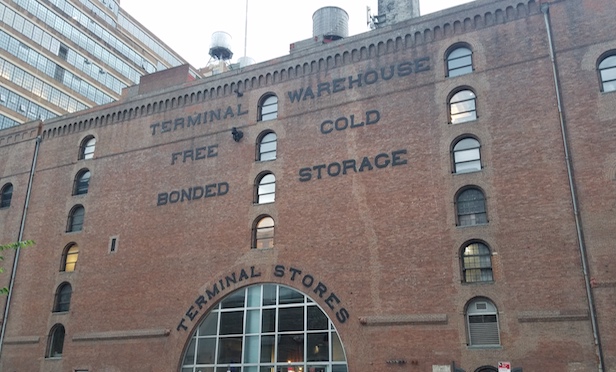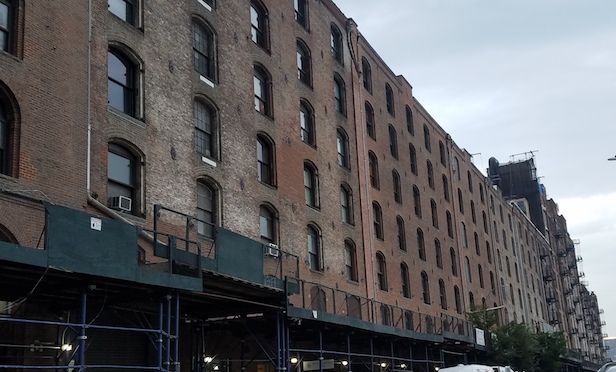 The Terminal Stores building recently sold for $900 million./photo by Betsy Kim
The Terminal Stores building recently sold for $900 million./photo by Betsy Kim
NEW YORK CITY—L&L Holding Co. and Normandy Real Estate Partners are buying Terminal Stores, at 271 Eleventh Ave. from Waterfront New York and GreenOak Real Estate Advisors for $900 million, as reported in The Wall Street Journal. CBRE's Darcy Stacom and Bill Shanahan represented the sellers.
The 1.3 million square-foot former warehouse extends from W. 27th to W. 28th streets, spanning Eleventh to Twelfth avenues. The WSJ noted the price tag was triple the property's valuation four years ago. In 1983, Waterfront purchased the property for $12 million. In 2014, when GreenOak acquired a 49% interest in the property, it was valued at $300 million. That partnership invested $50 million renovating office and retail space in the building.
Craig Leibowitz, Jones Lang Lasalle's director of research, New York, leads a team focused on the Midtown and Midtown South markets.
 Craig Leibowitz, JLL's director of research, New York
Craig Leibowitz, JLL's director of research, New York“This was a perfect storm,” Leibowitz tells GlobeSt.com. He points to the current, strong market conditions with historically record low unemployment and record high office-using employment. “Unlike with prior cycles, we have less reliance on financial services, and companies much more diversified and inclusive of tech and other creative firms are attracted to the type of product that Midtown South offers.”
The new owners are planning to convert 500,000 square feet in the building into space to lease. Leibowitz says there's an insatiable demand among the investor community for value-add product. “We have record levels of dry powder that's chasing opportunistic and value-add products specifically.” JLL estimates that two-thirds of fund strategies are dedicated to this segment.
 Terminal Stores on West 28th St., extending from Tenth Ave. to the West Side Highway/photo by Betsy Kim
Terminal Stores on West 28th St., extending from Tenth Ave. to the West Side Highway/photo by Betsy KimHe particularly notes tight occupier conditions in Midtown South within Chelsea, with JLL reporting a 4.9% vacancy rate. “This makes an opportunity to retrofit a building of this scope in a dynamic office district an attractive opportunity.”
Many creative firms are more attracted to brick and beam style product as opposed to the high efficiency, glass and steel towers found elsewhere in Manhattan. He compares the Terminal Stores to Chelsea Market, that's between Ninth and Tenth avenues, stretching from W. 15th to W. 16th streets. In February 2018, Google bought the property for $2.4 billion. It was originally built as the Nabisco factory complex. Retrofitting the property keeping much of the structure in place can lower costs. Leibowitz adds it is also stylistically appealing.
Leibowitz points to 111 Eighth Ave., the building across the street from Chelsea market, which Google purchased in Dec. 2010 for $1.77 billion. In addition, he references the St. John's terminal site, of which Oxford Properties Group and Canada Pension Plan Investment Board acquired the southern portion for $700 million.
Former warehouses have larger floor plates but there are very few options in Midtown South for the large block user occupying over 100,000 square feet of space.
Looking at the overall picture, Leibowitz points to the market slowdown. JLL reported slightly north of $100 billion of investment volume in Manhattan from January 2015 through December 2016. But from January 2017 though June 2018, JLL reported just $36 billion of investment volume combined.
He attributes the slowdown to factors such as a significant bid/ask pricing spread, fluid debt market conditions, higher interest rates and investment yields, and a slowdown in demand from select overseas institutions. However, JLL is monitoring several sizable buildings and portfolios that could boost dollar volume by the end of the year. Leibowitz nevertheless does not anticipate it will come close to reaching the 2015-2016 peak. He's not seeing property owners motivated to sell even partial interests in equity. Instead, Leibowitz has observed owners recapitalizing their product.
He opines that owners have more leverage in Midtown South than elsewhere in Manhattan due to the supply and demand imbalance. “This has allowed landlords who have retrofit properties to regularly achieve rents north of $90 per square foot, which is on par with trophy quality product usually found in Midtown,” says Leibowitz. “So, some investors would be well positioned to consider marketing their properties.”
© Touchpoint Markets, All Rights Reserved. Request academic re-use from www.copyright.com. All other uses, submit a request to [email protected]. For more inforrmation visit Asset & Logo Licensing.







